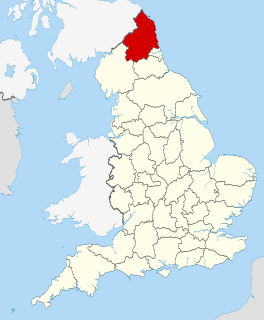
The Holy Island of Lindisfarne, also known simply as Holy Island, is a tidal island off the northeast coast of England, which constitutes the civil parish of Holy Island in Northumberland. Holy Island has a recorded history from the 6th century AD; it was an important centre of Celtic Christianity under Saints Aidan of Lindisfarne, Cuthbert, Eadfrith of Lindisfarne and Eadberht of Lindisfarne. After the Viking invasions and the Norman conquest of England, a priory was reestablished. A small castle was built on the island in 1550.

Malham Cove is a large curved limestone formation 0.6 miles (1 km) north of the village of Malham, North Yorkshire, England. It was formed by a waterfall carrying meltwater from glaciers at the end of the last Ice Age more than 12,000 years ago. Today it is a well-known beauty spot within the Yorkshire Dales National Park. A large limestone pavement is above the cove.
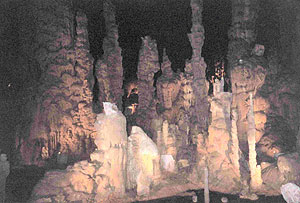
Cathedral Caverns State Park is a publicly owned recreation area and natural history preserve located in Kennamer Cove, approximately 5 miles (8.0 km) northeast of Grant and 7 miles (11 km) southeast of Woodville in Marshall County, Alabama. The state park's main feature, first known as Bats Cave, was developed as a tourist attraction in the 1950s. Cathedral Caverns was declared a National Natural Landmark in 1972 and opened as a state park in 2000.
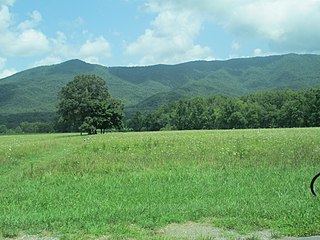
Cades Cove is an isolated valley located in the Tennessee section of the Great Smoky Mountains National Park, USA. The valley was home to numerous settlers before the formation of the national park. Today Cades Cove, the single most popular destination for visitors to the park, attracts more than two million visitors a year because of its well preserved homesteads, scenic mountain views, and abundant display of wildlife. The Cades Cove Historic District is listed on the National Register of Historic Places.
The Yeocomico River is a 1.1-mile-long (1.8 km) tidal tributary of the southern portion of the Potomac River in Virginia's Northern Neck. The Yeocomico forms the boundary between Westmoreland and Northumberland counties. Yeocomico is a Native American name roughly translated as "tossed to and fro by the waters." Others suggest it is an Algonquian word that means "four dwelling places" since the river has a branch on either side with each dividing into two large forks.

Carboniferous Limestone is a collective term for the succession of limestones occurring widely throughout Great Britain and Ireland that were deposited during the Dinantian Epoch of the Carboniferous Period. These rocks formed between 363 and 325 million years ago. Within England and Wales, the entire limestone succession, which includes subordinate mudstones and some thin sandstones, is known as the Carboniferous Limestone Supergroup.
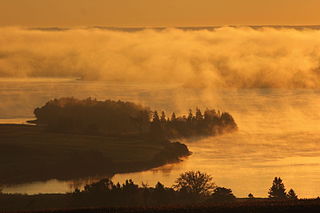
The Sunrise Trail is a scenic roadway in the Canadian province of Nova Scotia.

Bossiney Haven is a small cove in the civil parish of Tintagel. It is on the north coast of Cornwall, United Kingdom and a mile east of Tintagel and three miles west of Boscastle. The South West Coast Path closely follows the coast above the cove.
Crestwood/Glen Cove is a community in Houston, Texas. It consists of the Crestwood and Glen Cove subdivisions. The Crestwood/Glen Cove Civic Club serves the Crestwood/Glen Cove community.

St Cuthbert's Cave, known locally as Cuddy's Cave or Cove, can refer to one of two natural sandstone caves in Northumberland that have been traditionally associated with Saint Cuthbert, the seventh century Anglo-Saxon monk, bishop and hermit.

Northumberland Fire and Rescue Service is the statutory fire and rescue service which covers the area of Northumberland, England.

Cleeves Cove or Blair Cove is a solutional cave system on the Dusk Water in North Ayrshire, Scotland, close to the town of Dalry.

Grassy Cove is an enclosed valley in Cumberland County, Tennessee, United States. The valley is notable for its karst formations, which have been designated a National Natural Landmark. Grassy Cove is also home to a small unincorporated community.

The Caves of Drach are four great caves that are located in the island of Majorca, Balearic Islands, Spain, extending to a depth of 25 m and reaching approximately 4 km in length. They are in the municipality of Manacor, near the locality of Porto Cristo. They were first mentioned in a letter dated 1338. The four caves, called Black Cave, White Cave, Cave of Luis Salvador, and Cave of the French, are connected to each other.

Alloa Lea Quarry Cave is a short cave in the Five Yard Limestone of the Alston Block in Northumberland, England. It is situated in an old quarry on the road between Alloa Lea and Walltown. The total length of the cave is 10m.

Lost Cove Cave, also known as Buggytop Cave, is a cave in Franklin County, south Tennessee near the towns of Sewanee and Sherwood and close to the Alabama border. It is noted for its large main entrance and the extensive archeological artifacts of the Woodland and Mississippian periods found inside.
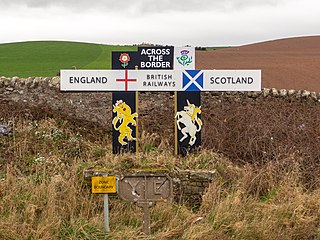
Marshall Meadows Bay is the northernmost point of England. It is located on the Northumberland coast, 2.5 miles (4.0 km) to the north of Berwick-upon-Tweed, and just to the south of the Anglo-Scottish border. Across the border in Scotland is the county of Berwickshire in the Borders region. The hamlet of Marshall Meadows lies to the west of the bay, and is the most northerly inhabited place in England. The Marshall Meadows Country House Hotel is here, along with a farm and a caravan site. There is a disused tunnel from the caravan site to the bay below, and there is a small cave 300m north of this tunnel, plus another small cave just around the corner of Marshall Meadows Point. Nearby is the A1 trunk road and the East Coast Main Line railway.

Smuggler’s Cove Provincial Park is located in Meteghan, Digby County, Nova Scotia, Canada and can be found alongside Highway 1 in the Yarmouth and Acadian Shores region. Smuggler’s Cove is known for the small cave in the cliff used for the smuggling of liquor during prohibition in the 1920s. The ocean waters fill the cove during high tide which prevents access to the cave, but it can be traversed briefly during low tide.

Peden's Cave is at least partly artificial and is set into a craggy outcrop of red sandstone rocks overlooking the River Lugar just below the farm of Auchinbay in East Ayrshire, Scotland, close to the town of Ochiltree. Traditionally it is said that this cave was used as a hiding place for Covenanters, including the famous Covenanter minister Alexander Peden in the 17th century, mainly during the so called 'Killing Times' of the 1680s.

Bruce's Cave or the Dunskellie Grotto is a relatively small and mainly artificial cave created in the red sandstone cliffs about 9 metres above the Kirtle Water at Cove, Kirkpatrick-Fleming, Dumfries and Galloway, Scotland. It has been associated with Robert the Bruce and the famous incident with the spider struggling to build its web.

